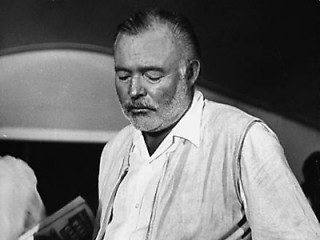
Ernest Hemingway biography
Date of birth : 1899-06-21
Date of death : 1961-06-02
Birthplace : Oak Park, Illinois, U.S.
Nationality : American
Category : Arts and Entertainment
Last modified : 2010-05-07
Credited as : Writer/novelist and journalist, The Old Man and the Sea, Nobel Prize in Literature
Although his most famous work is The Old Man and the Sea, winning him a Nobel prize in Literature, Ernest Hemingway’s rise to fame occurred with the release of his short story collection in Europe and the United States entitled In Our Time. His first novel released was The Sun Also Rises and his group of short stories Men Without Women solidified him as one of America’s newest literary prose masters.
Born in Illinois to a father who was a doctor and a mother who had some success in music, young Ernest grew up without want. He did take up many outdoor activities that his father enjoyed, including hunting, fishing, and camping. His works would often display a protagonist with a special connection to nature, to the water, and to the freedom it brought.
Hemingway graduated from high school at the age of 17 and immediately started writing and working for the Kansas City Star. While his short stint there didn’t last as long as he intended, it paved the way for his own emerging style of writing using short, terse sentences that played an important part in the work as a whole. Through poignant and planned phrases, readers would have to feel and search beneath what was on the page for deeper meanings. World War I ended his work at the Kansas City Star and Hemingway attempted to join the Army, but was turned down. Instead, he joined the Red Cross Ambulance Corps and was off to Italy.
World War I was a time of growth and change for the young writer. He would witness first hand the trauma and grotesque nature of those who suffered and were affected on the front. During his service, an Austrian mortar shell hit his ambulance. First, he managed to rescue another soldier and drag him to safety, then Hemingway was taken to a Red Cross hospital where he was nursed back to health. During his recovery, he fell in love with a nurse who promised to meet him back in the United States. When she did not, the events inspired one short story called A Very Short Story and his full-length book entitled A Farewell to Arms.
Hemingway eventually moved to Paris, France with his new wife Hadley and his son John. While there, he met some of the literary world’s most prominent figures, including Gertrude Stein and F. Scott Fitzgerald.
After the success of his short-story collections and his first books, Hemingway became independently wealthy. He later returned to the United States and lived in Key West, Florida for a time. He also bought property outside of Havana in Cuba and was hired by the U.S. Government to spot German submarines from his fishing boat. After returning to Idaho to receive treatment for his ailments caused by adventurous escapades gone awry and heavy drinking, he committed suicide blaming the shock-therapy treatments he had been receiving.
















